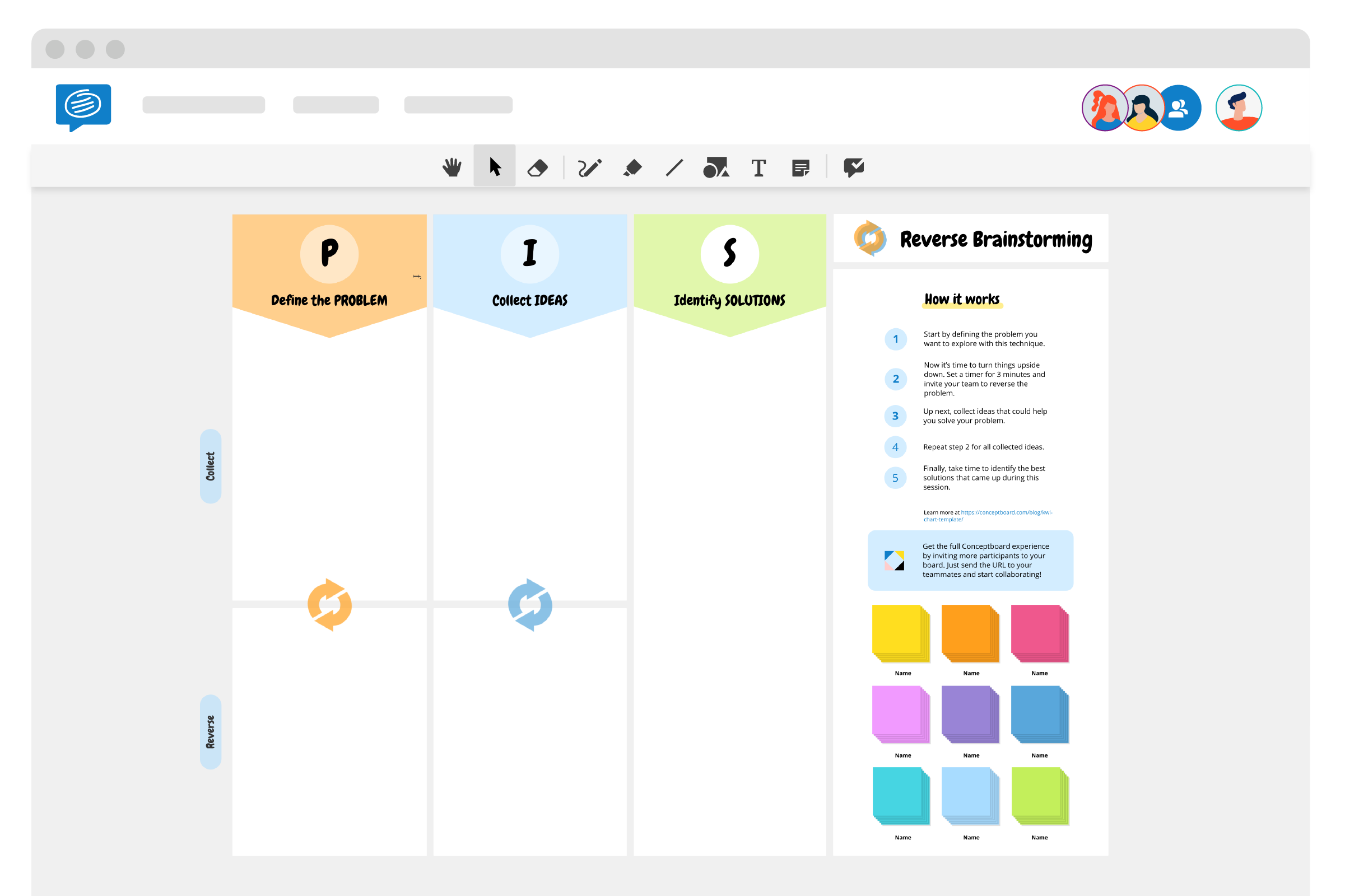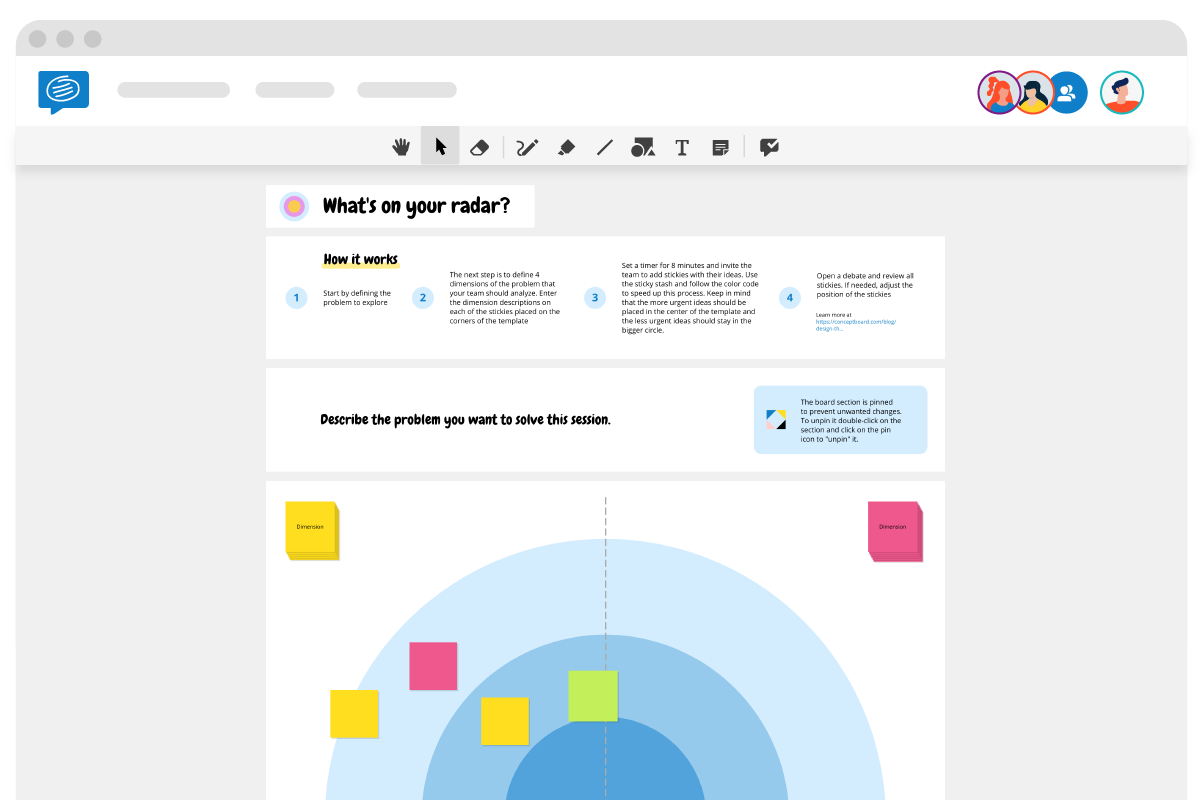This post is also available in: German
Have you put brainstorming on hold since your team went remote? Or perhaps you’re struggling to find a way to problem solve if you’re not sitting around a big whiteboard? Not to worry, we’re here to help! These 15 brainstorming techniques have all been adapted for online brainstorming sessions.
Whether you’re running brainstorming sessions as a part of a design thinking workshop, a UX design sprint or ideating on strategy for your next big launch, these 15 alternative brainstorming techniques are sure to take your creativity and idea generation to the next level!
They provide more structure and alternate ways of looking at problems to help you get better solutions. Best of all, each brainstorming technique comes with a customizable template, so all you have to do is click the image to get started.
15 brainstorming techniques for remote teams in 2025
1. Mind mapping
Mind Maps are a great technique to organize information, connect related ideas, and help capture the flow of ideas during a brainstorming session. Importantly, visualizing ideas and concepts on a Mind Map allows you to showcase your thoughts in an organic, yet easy-to-follow manner. This mimics the way the mind works!
2. Brainwriting
Put simply, brainwriting is the introvert’s version of brainstorming. Firstly, each person is given a blank page to write down three ideas, then after five minutes, all pages are passed onto someone else, who can continue to expand on those existing ideas or add their own.
Brain writing is designed to reduce the unnecessary chit-chat and allow everyone to simultaneously add ideas, thus speeding up the process, and reducing social anxiety. Perhaps best of all, brain writing is effective at eliminating blocking: the problem where people forget or dismiss their own ideas due to one person dominating the discussion with their ideas.

3. Lotus Diagram
Named after its blossoming grid system, a lotus diagram is a simple brainstorming technique for idea generation based on one central topic. This initial central topic blossoms out to generate eight new ideas. From there, each of these ideas can again blossom out into 16 more ideas, creating at least 24 potential solutions.

4. Reverse brainstorming techniques
Reverse brainstorming is a creative technique used to flip our perspective and turning problems into opportunities. In reverse brainstorming, you start by considering all the possible problems that you might encounter, eg: competitors release similar shoes, website crashes, leather supplier closes down. This will help you generate more relevant and directly applicable ideas. It also shakes up the old way of doing things, pushing the brain in a new direction.

5. Round Robin brainstorming techniques
The major benefit of Round Robin brainstorming is being able to harness multiple ideas to solve problems. What sets it apart is its collaborative structure that allows all voices to be heard. With Round Robin, not only do all participants visualize their ideas using text and sketches (instead of verbally), it also places equal value on all ideas.
The other major benefit of Round Robin brainstorming is that you identify and solve potential roadblocks before the idea has even left the paper. This is a great way to consider the true value of the idea before investing too much time or energy into the idea.

6. How Might We
How Might We is a brainstorming technique that invites teams to think about creative ways to solve problems. The framework welcomes all ideas without judgment, before jumping straight into finding one solution. Moreover, it places value on teamwork by focusing on how might WE as a team solve this. So, if your team struggles when it comes to innovating, it might be time to introduce How Might We as the prompt for your next brainstorming session.

7. Six Thinking Hats
Look at problems from six different perspectives with the six thinking hats brainstorming technique. The Six Thinking Hats is a parallel thinking technique that helps teams approach problems from different angles. The figurative hats you wear are:
Blue: managing and organizing the process
Red: emotions and feelings
Black: cautious & critical thinking
Yellow: positive thinking and benefits
Green: creativity
White: information & facts

8. Affinity Diagrams
An Affinity Diagram is a visual map that organizes ideas into categorized clusters after the initial brainstorming. This process of creating affinity diagrams is known as affinity mapping. Affinity mapping allows all ideas to be strategically analyzed, instead of just focusing on one or two standouts. As clear themes start to emerge, you can consider multiple solutions to each problem. This brainstorming technique works well for Six Sigma, Design Thinking and UX Design.

9. What’s on your radar
A typical brainstorming session should generate a wide range of ideas without considering potential constraints. So once you’ve dumped a number of ideas on your board, the ‘What’s on your radar’ brainstorming template is a great way to rank ideas and concepts in order of importance or feasibility. Place the most important ideas in the center of the template and the less important ones closer to the periphery. The 4 quadrants help further categorize the ideas.

10. Fishbone diagram
A Fishbone Diagram is a cause and effect analysis technique used to brainstorm potential causes of a problem. It’s clear, visual design lends itself to collaborative problem-solving.
When conducting a fishbone analysis, teams work together to categorize the factors contributing to a problem to uncover the major issues. This root cause analysis will produce a map of the main contributing factors, so you can address the problems rather than just the symptoms.

11. Crazy Eights
The Crazy Eights technique is a great way to quickly generate a wide range of diverse ideas from the whole team. The concept is simple: give each team member eight minutes to sketch out eight ideas on a Crazy Eights template. The frenzy that follows can produce some pretty wild ideas. Due to its illustrative nature, it’s highly popular for UX design, prototyping and Design Thinking.

12. SCAMPER brainstorming techniques
SCAMPER is a brainstorming technique that expands your lateral thinking in seven different directions. The SCAMPER acronym stands for:
- Substitute
- Combine
- Adapt
- Modify
- Put to another use
- Eliminate
- Reverse
These seven prompts will help boost your creativity and push your thinking in new directions when it comes to developing new products or improving current ones.


Try these brainstorming techniques with your remote team
Hopefully, these 15 techniques can help open your eyes to the many ways to approach problem-solving when working remotely. Conceptboard’s infinite, collaborative whiteboard is the perfect complement to an online brainstorming session.
Use digital sticky notes, shapes, line connectors, sketching tools and more to spark creativity and bring your ideas to life. Learn more about best practices for running online brainstorming sessions in virtual teams in 2025.
Learn more about the future of remote work, virtual collaboration or brainstorming, on our blog.
If you want to give Conceptboard a try, get started for free now.








7 Comments. Leave new
Excellent resource.
Fantastic tools. I’m impressed. Thank you
Creative problem-solving techniques like brainstorming are probably among the most well-known. The core of brainstorming is the ability to ask questions so effectively that answering them will result in generating new ideas. Brainstorming templates come in handy in this case, thank you for sharing yours!
Thank you Kat Barber! These all have the potential for supporting a variety of personal or business projects. Ange
Thank you – I work with small to mid sized companies in regards to bookkeeping and company growth. These templates will help facilitate visual brainstorming.
Hey Alana,
we are very glad to hear this! Please also check out our other templates regarding brainstorming, such as the Business Ideaboard or Bull’s Eye Diagram.
You can find them in the template category “Brainstorming”. Hope this helps!
Best regards,
Linda
very nice thought